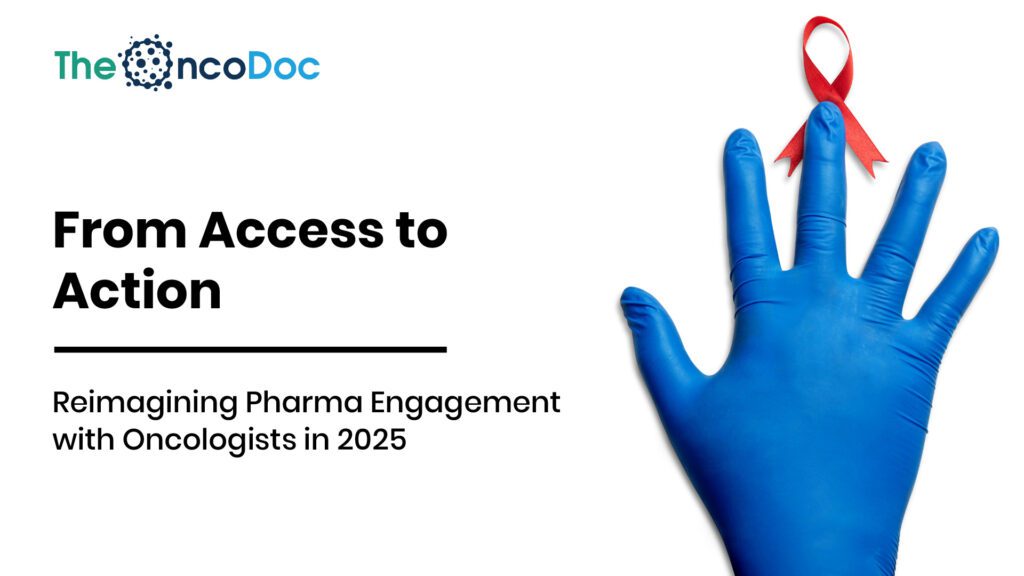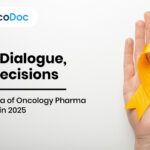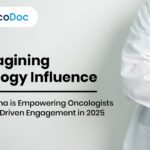Introduction: Closing the Communication Gap in Oncology Marketing
The oncology treatment paradigm has shifted dramatically by 2025, with advances in precision medicine, immunotherapy, and data-driven diagnostics redefining cancer care. But while treatments advance, the way pharmaceutical companies communicate with oncologists still lags. Traditional marketing tactics-email blasts, static brochures, and overly generalized messages-no longer resonate with today’s oncology professionals.
To succeed in this new era, pharma marketers must focus not just on access but on action. They must understand oncologists’ evolving expectations, clinical challenges, and preferred channels. This article explores how pharma can reimagine its marketing efforts to move beyond transactional communication and into meaningful, outcome-driven collaboration.
It outlines 20 distinct strategies-spanning personalization, localization, technology, education, and post-care engagement-to help pharmaceutical brands remain credible, useful, and relevant in oncology communication.
1. Understanding the Modern Oncologist’s Information Needs
Today’s oncologist operates in a high-pressure, fast-paced environment. With limited time and increasing complexity in treatment options, they need communication that is:
- Concise and evidence-based
- Immediately applicable to clinical practice
- Customizable to patient profiles and tumor biology
A recent study found that 72% of oncologists prefer content that addresses real-time clinical dilemmas over promotional materials. This insight is foundational: pharma marketing must shift from product-centric messaging to insight-driven support.
One clear example is Novartis’ targeted approach with their breast cancer drug campaigns. Upon learning that many oncologists in India’s Tier-1 cities struggled with interpreting HER2-low results in early-stage patients, Novartis created modular e-learning capsules on HER2-low biology, backed by case discussions and regional expert commentary. This campaign not only clarified the scientific rationale but positioned Novartis as a thought partner rather than a seller. The result? A significant uptick in adoption within those regions.
Today’s oncologist operates in a high-pressure, fast-paced environment. With limited time and increasing complexity in treatment options, they need communication that is:
- Concise and evidence-based
- Immediately applicable to clinical practice
- Customizable to patient profiles and tumor biology
A recent study found that 72% of oncologists prefer content that addresses real-time clinical dilemmas over promotional materials. This insight is foundational: pharma marketing must shift from product-centric messaging to insight-driven support.
2. Redefining Content Value: Beyond the Product Brochure
Oncologists now prioritize resources that enhance their clinical efficiency and decision-making. These include:
- Interactive case simulations
- Treatment sequencing visuals
- Prognostic biomarker explainers
- Digital tools to aid in therapy selection
Such content ensures that the communication is not only welcomed but retained and applied.
3. Personalization at Scale: The New Engagement Gold Standard
AI and machine learning tools have made it possible for pharma to create tailored communication strategies for oncologists. By analyzing:
- Search behavior on medical portals
- Participation in CMEs
- Content interaction patterns (e.g., video vs. text)
…marketers can now personalize delivery methods, message tone, and frequency. Personalized engagement not only boosts relevance but also strengthens trust and attention.
4. Why Timeliness Is Critical in Oncology Communication
The value of information is directly tied to its timing. An oncologist dealing with a rare lung mutation today doesn’t need a breast cancer update-they need content that serves their immediate clinical reality.
AI tools can flag content needs by region, specialty, and even by EMR search behavior. This allows pharma to provide just-in-time content that feels predictive and supportive, not interruptive.
5. Oncologists Prefer Education Over Promotion
Content marketing must evolve into educational marketing. Oncologists consistently rate learning-led touchpoints (CME, clinical quizzes, decision trees) as more valuable than brand marketing.
6. Localizing to Context: Geography Still Matters in 2025
India’s healthcare landscape is highly heterogeneous. For example, oncologists in urban Tier-1 cities may request immunotherapy updates, while those in semi-urban areas seek help with chemotherapy supply chains.
Pharma marketers must:
- Understand regional cancer incidence trends
- Tailor formats (vernacular, visual, audio)
- Deploy hyperlocal insights through digital and rep channels
Localized messaging delivers higher impact because it resonates with real-world practice gaps.
For instance, a recent breast cancer awareness initiative in Gujarat saw higher engagement when the campaign incorporated Gujarati-language visuals and videos featuring local oncologists. In contrast, the same campaign using English-language content failed to generate traction in nearby rural districts. This clearly demonstrated that regional tailoring-not just translation-was vital for meaningful communication. As a result, the brand reallocated resources to develop state-wise templates for future outreach.
India’s healthcare landscape is highly heterogeneous. For example, oncologists in urban Tier-1 cities may request immunotherapy updates, while those in semi-urban areas seek help with chemotherapy supply chains.
Pharma marketers must:
- Understand regional cancer incidence trends
- Tailor formats (vernacular, visual, audio)
- Deploy hyperlocal insights through digital and rep channels
Localized messaging delivers higher impact because it resonates with real-world practice gaps.
7. From Channels to Journeys: Coordinating Omnichannel Strategy
Successful marketing today isn’t about being present on all channels-it’s about being meaningfully present on the right ones, in sequence.
8. Humanizing the Brand Through Peer Voices
Oncologists trust their peers more than any rep or algorithm. Pharma companies that collaborate with clinicians to co-create content not only enhance credibility but also improve engagement.
Examples:
- Peer-led CME programs
- Co-developed patient case explainers
- Regional roundtables on drug adaptation
These peer-led initiatives boost authenticity and reduce perceived bias, especially when frontline clinicians share personal case outcomes and real-world experience with new therapies. For instance, an internal study by a leading pharmaceutical company revealed that CME sessions led by KOLs (Key Opinion Leaders) achieved a 45% higher retention rate and 37% greater post-session prescription intent compared to traditional branded webinars. This not only validates the peer-trust dynamic but also highlights measurable business impact when trust is prioritized in content design.
Oncologists trust their peers more than any rep or algorithm. Pharma companies that collaborate with clinicians to co-create content not only enhance credibility but also improve engagement.
Examples:
- Peer-led CME programs
- Co-developed patient case explainers
- Regional roundtables on drug adaptation
9. Ethical Framing: Building Credibility Through Transparency
Oncologists are data-savvy. Any attempt at emotional manipulation or selective reporting is quickly identified-and rejected. Pharma content must:
- Clearly cite trial limitations
- Avoid absolute claims or overstatements
- Contextualize patient subgroups and endpoints
10. Bridging the Diagnostic Gap with Actionable Tools
Early cancer detection is a national priority. Pharma brands can aid diagnosis by offering:
- Referral algorithms for primary care physicians
- Risk stratification tools for nurses
- Diagnostic timelines based on tumor biology
11. Clinical Decision Support Is the Future of Marketing
Pharma can drive significant goodwill by embedding its messages into tools oncologists use every day:
- EMR plugins for treatment options
- WhatsApp bots for rapid triage
- On-demand treatment cost estimators
12. Supporting the Full Cancer Care Team
Cancer care is now a collaborative discipline. Oncology nurses, treatment coordinators, and nutritionists each play pivotal roles-shaping clinical workflows, patient motivation, and long-term outcomes through their day-to-day interactions. Pharma must:
- Provide resources beyond physicians
- Design materials for multi-stakeholder teams
- Consider caregiver dynamics in communication
13. Vernacular and Voice: Reaching the Underserved
Pharma brands often ignore regional and underserved markets. Yet these are precisely where cancer mortality can be reduced most.
Strategies include:
- Voice-based CME podcasts
- IVR platforms in local languages
- Rural screening campaigns with digital education
14. Post-Therapy Content: Staying Relevant Beyond Prescription
Pharma can stay involved after the drug is prescribed by offering:
- Lifestyle guidance modules
- Return-to-work tools
- Symptom management charts
15. AI-Augmented Reps: The New Face of Pharma
Reps in 2025 aren’t product pushers. With AI dashboards, predictive alerts, and real-time clinical content access, they serve as solutions consultants.
A rep visiting a GI oncologist may show:
- A region-specific clinical update
- Recent NGS test adoption data
- Personalized patient profiles for treatment optimization
To illustrate, consider the day of Meera, an AI-augmented oncology sales representative for a global pharma company. Her morning begins with a dashboard highlighting her top oncologist targets based on recent clinical queries and prescription patterns in her territory. Before heading to a hospital in Bengaluru, she reviews the digital assistant’s brief for Dr. Kapoor, a colorectal cancer specialist who has recently searched for MSI-H biomarker data. Armed with predictive insights, Meera enters the meeting with a tablet loaded with a visual comparison of therapy sequencing strategies, patient case studies, and cost-efficacy ratios tailored to the region’s formulary.
Post-meeting, she uses voice-to-text to record engagement outcomes, which are immediately fed into the CRM. The AI system then triggers an email follow-up with supplementary clinical literature and a peer CME invite. Her role is no longer limited to detailing products; she’s now a facilitator of decision support, reducing friction between evidence and execution. This redefinition of the rep profile enhances brand credibility, improves content recall, and ultimately supports better patient outcomes.
Reps in 2025 aren’t product pushers. With AI dashboards, predictive alerts, and real-time clinical content access, they serve as solutions consultants.
A rep visiting a GI oncologist may show:
- A region-specific clinical update
- Recent NGS test adoption data
- Personalized patient profiles for treatment optimization
16. Smart Data Feedback Loops: Closing the Insight-Action Gap
Effective marketing must be iterative. Pharma companies can use post-engagement metrics to:
- Adjust content timing and tone
- Track content performance by specialty
- A/B test message formats for microsegments
With platforms like CRM-integrated analytics dashboards, feedback is not an endpoint but a constant loop of refinement.
17. Enhancing Virtual Event ROI with Hybrid Models
Virtual CMEs saw a boom during the pandemic, but fatigue has set in. The most successful campaigns now blend:
- Short in-person focus groups
- Pre-recorded video explainers
- Live Q&A sessions for case-based interaction
Hybrid models offer the flexibility of online with the engagement depth of offline events.
18. Patient-Reported Outcome Integration
Oncologists appreciate pharma data on PROs (Patient-Reported Outcomes), which go beyond survival to address real-life quality indicators like:
- Fatigue and appetite levels
- Emotional resilience
- Financial toxicity
Pharma can collect anonymized PROs through follow-up apps and embed insights into educational content for oncologists.
19. Visual Learning Assets: Making Complex Data Digestible
Infographics, explainer videos, and interactive dashboards are critical in making clinical trial data accessible. Especially in molecular oncology, where mechanisms of action and mutation pathways are complex, visual storytelling improves comprehension and adoption.
20. Pharmacoeconomics: Communicating Value Beyond Efficacy
In India and similar markets, oncologists must weigh not only effectiveness but affordability and access. Pharma can:
- Provide comparative cost charts
- Offer access pathways for patients
- Publish economic impact models for payers
Helping oncologists navigate these realities adds practical value that builds long-term brand affinity.
Conclusion: The New Oncology Marketing Playbook
Pharma marketers in 2025 must shift from volume to value, from frequency to relevance. Whether through peer-led education, localized engagement, or AI-personalized experiences, the future belongs to brands that respect the oncologist’s workflow and clinical purpose.
Marketing isn’t just communication. In oncology, it’s contribution.
The Oncodoc team is a group of passionate healthcare and marketing professionals dedicated to delivering accurate, engaging, and impactful content. With expertise across medical research, digital strategy, and clinical communication, the team focuses on empowering healthcare professionals and patients alike. Through evidence-based insights and innovative storytelling, Hidoc aims to bridge the gap between medicine and digital engagement, promoting wellness and informed decision-making.



